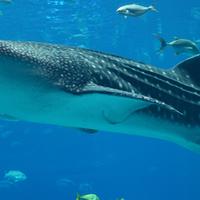Whale Sharks – level 2
Walhaie - Stufe 2
Καρχαρίες φάλαινες - επίπεδο 2
Whale Sharks – level 2
Tiburón ballena - nivel 2
Requins-baleines - niveau 2
Squali balena - livello 2
ジンベエザメ - レベル2
고래 상어 - 레벨 2
Rekiny wielorybie - poziom 2
Tubarões-baleia - nível 2
Китовые акулы - уровень 2
Balina Köpekbalıkları - seviye 2
Китові акули - рівень 2
鲸鲨 – 2 级
鯨鯊 – 2 級
The whale shark is sometimes called the mystery species, as it is a big animal but we know very little about it.
|鯨魚|鯊魚||||||物種|||||||||||||
||||||||вид|||||||||||||
Der Walhai wird manchmal als geheimnisvolle Spezies bezeichnet, da er ein großes Tier ist, über das wir nur sehr wenig wissen.
The whale shark is sometimes called the mystery species, as it is a big animal but we know very little about it.
El tiburón ballena a veces se llama la especie misteriosa, ya que es un animal grande pero sabemos muy poco al respecto.
ジンベイザメは大きな動物であるため、ミステリー種と呼ばれることもありますが、私たちはそれについてほとんど知りません。
Китовую акулу иногда называют таинственным видом, так как это большое животное, но мы очень мало знаем о нем.
To find out more, scientists are diving into the waters around the Galapagos Islands.
||||||||||||加拉巴哥|
||||вчені||пірнають у води|||||||
Um mehr darüber herauszufinden, tauchen Wissenschaftler in die Gewässer rund um die Galapagos-Inseln.
To find out more, scientists are diving into the waters around the Galapagos Islands.
Para obtener más información, los científicos se sumergen en las aguas que rodean las Islas Galápagos.
詳細を調べるために、科学者たちはガラパゴス諸島周辺の海域に飛び込んでいます。
Para descobrir mais, os cientistas estão a mergulhar nas águas das Ilhas Galápagos.
Чтобы узнать больше, ученые ныряют в воды вокруг Галапагосских островов.
The animal can weight up to 18 tons and their size ranges from 6 to 16 meters in length.
|||||||||||||||у довжину
Die Tiere können bis zu 18 Tonnen wiegen und sind zwischen 6 und 16 Meter lang.
The animal can weight up to 18 tons and their size ranges from 6 to 16 metres in length.
El animal puede pesar hasta 18 toneladas y su tamaño oscila entre los 6 y los 16 metros de longitud.
動物の体重は最大18トンで、体長は6〜16メートルです。
The whale sharks are very big, but they only eat very small fish and plankton.
||||||||||||||浮游生物
Die Walhaie sind sehr groß, aber sie fressen nur sehr kleine Fische und Plankton.
Los tiburones ballena son muy grandes, pero solo comen peces muy pequeños y plancton.
ジンベイザメは非常に大きいですが、彼らは非常に小さな魚とプランクトンしか食べません。
Scientists want to know more about them such as the shark's mating, where they have their pups and how the pups live.
||||||||||鯊魚的|交配|||||幼鯊魚|||||
||||більше інформації|||||||спарювання акули|||||дитинчата акул|||||
Die Wissenschaftler wollen mehr über sie erfahren, z. B. wie sich die Haie paaren, wo sie ihre Jungen bekommen und wie die Jungen leben.
Los científicos quieren saber más sobre ellos, como el apareamiento del tiburón, dónde tienen sus crías y cómo viven las crías.
科学者たちは、サメの交配、子犬のいる場所、子犬の生活など、彼らについてもっと知りたいと思っています。
Os cientistas querem saber mais sobre eles, como o acasalamento dos tubarões, onde têm as suas crias e como vivem as crias.
Ученые хотят знать о них больше, например, о спаривании акул, о том, где у них рождаются детеныши и как они живут.
Scientists want to help whale sharks so they also need to know where they travel in the ocean.
Um den Walhaien zu helfen, müssen die Wissenschaftler auch wissen, wo sie sich im Meer bewegen.
Los científicos quieren ayudar a los tiburones ballena, por lo que también necesitan saber a dónde viajan en el océano.
科学者はジンベイザメを助けたいので、彼らが海のどこを旅するかも知る必要があります。
Difficult words: species (an animal kind), plankton (very small organisms or animals in the water), mate (come together to have babies), pup (a baby animal such as a shark).
|||||||||生物體||||||交配|||||||||||||
|||||||||||||||спарюватися|||||||||||||
Schwierige Wörter: Spezies (eine Tierart), Plankton (sehr kleine Organismen oder Tiere im Wasser), paaren (zusammenkommen, um Babys zu bekommen), Welpe (ein Tierbaby wie ein Hai).
Palabras difíciles: especie (un tipo de animal), plancton (organismos muy pequeños o animales en el agua), compañero (se unen para tener bebés), cachorro (un animal bebé como un tiburón).
難しい言葉:種(動物の種類)、プランクトン(非常に小さな生物または水中の動物)、仲間(一緒になって赤ちゃんを産む)、子犬(サメなどの動物の赤ちゃん)。
You can watch the original video in the Level 3 section.
Puedes ver el video original en la sección Nivel 3.
Anda dapat menonton video aslinya di bagian Level 3.
オリジナルビデオはレベル3のセクションで視聴できます。

